This was published 1 year ago
Antarctica cruise: Following in the wake of Sir Ernest Shackleton, 100 years after his death
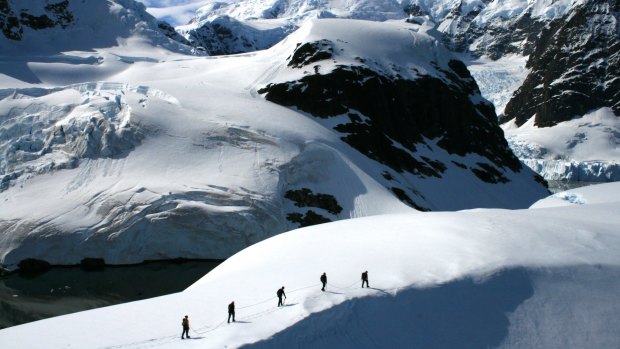
Trekking Almirante Peak, near Neko Harbour.Credit: Tarn Pilkington
For most historians, the demise of Sir Ernest Shackleton a century ago marked the end of what became known as the "Heroic Age of Antarctic Exploration".
Of all the august figures of that golden and at times tragic period of discovery – Amundsen, Scott, Mawson and others – it's Shackleton who stands alone as a man who failed in his objectives every time he travelled south but who somehow kept returning alive with his men also surviving.
January marked 100 years since the death of Shackleton, arguably the most courageous, if not successful, of all the continent's great explorers.
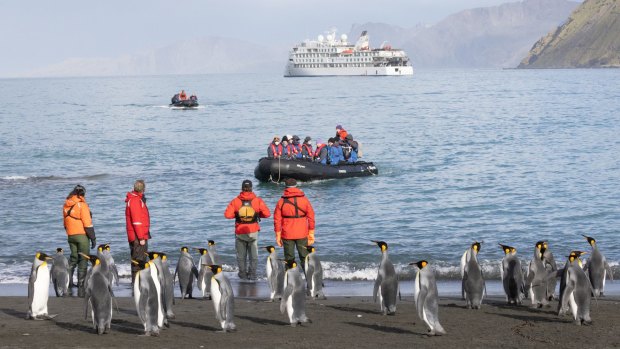
Landing among the penguins at Gold Harbour, South Georgia.Credit: Jocelyn Pride
The most daring and miraculous of these adventures was the 1914-17 Imperial Trans-Antarctic Mission, during which the man they called "The Boss" was supposed to lead a party across Antarctica, only to be trapped by ice in the Weddell Sea where his ship, the Endurance, was crushed and sunk.
From there, he instead led a mad dash back to a Norwegian outpost on South Georgia, sailing a little whaling boat to raise the alarm.
All these years later, I'm about to sail in Shackleton's wake aboard Aurora Expeditions' Greg Mortimer – first to the Antarctic Peninsula, then up to South Georgia and finally back to South America. Myself and my fellow passengers had mostly packed our bags when some extraordinary news broke in Antarctica.
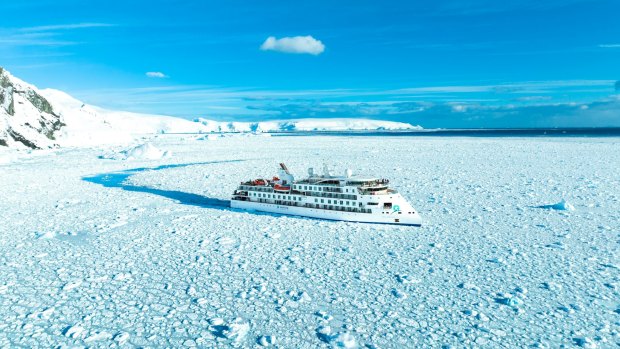
The Greg Mortimer cuts through ice.Credit: Tyson Mayr
A privately funded expedition known as Endurance22 had completed its mission to find Sir Ernest Shackleton's sunken ship at the bottom of the sea. It's the most exquisite timing for this voyage.
As welcoming cocktails are served on the first day of our own voyage south, there is excited discussion of the fantastically clear footage of the wreck sitting uncannily upright and curiously preserved on the ocean floor, as instantly recognisable as it was when last seen 107 years earlier.
If it already felt like we were chasing Shackleton's ghost here on this long expedition voyage, it now feels like we can just about touch it.
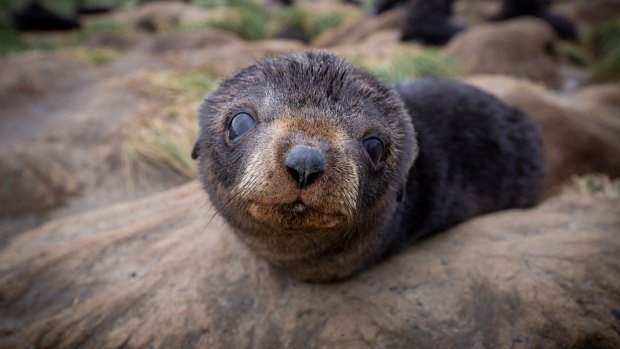
A fur seal pup.Credit: Jamie Lafferty
DAYS ONE TO SEVEN
IN SEARCH OF SHACKLETON, FROM PUNTA ARENAS TO THE ANTARCTIC PENINSULA
We arrive in the Antarctic Peninsula, having departed from Punta Arenas in Chile, feeling as though we've been abducted. For two days, thick clouds made us feel like we'd had a collective grey hood over us. Now the clouds have suddenly lifted, our eyes struggle to adjust to what lies before us.
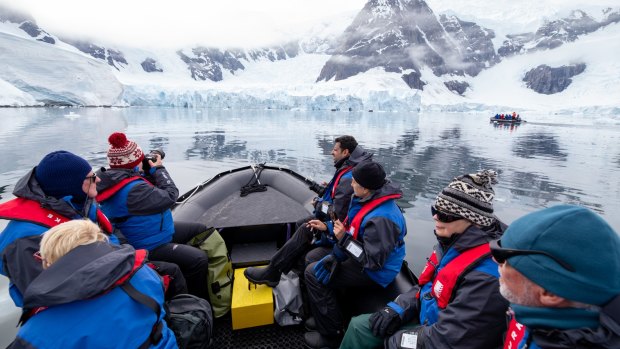
An ice safari off Prospect Point on the Antarctic Peninsula.Credit: Jamie Lafferty
Ahead, the cold sea is the colour and sheen of polished steel, its ominous darkness helping the gas-flame blues of icebergs dazzle in surface reflections. The air is windless and the scenery so flawless that first-time visitors struggle to properly comprehend it.
While there had been plenty of talk of Shackleton during our crossing, this first week is spent roughly following another, less famous mission: Adrien de Gerlache's calamitous 1897-99 Belgian Antarctic Expedition.
That voyage is remembered for the squalor, insanity and death on board his ship, the Belgica, though many of the places named after the mission are extraordinarily beautiful.
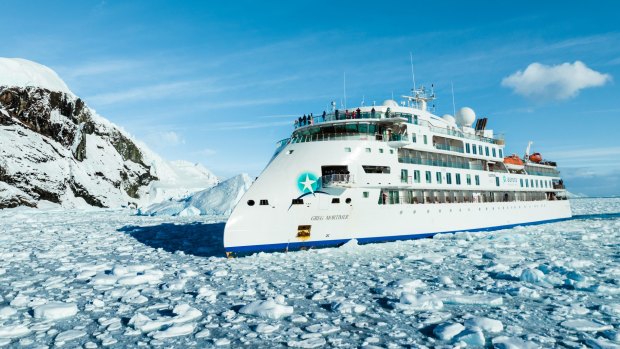
The Greg Mortimer.Credit: Tyson Mayr
These places are also often on the itineraries of modern luxury cruise ships – including ours – which serve lavish meals of which the men of the Belgica could have only fantasised about.
The vast Gerlache Strait is one of the most beautiful in the region, only surpassed by the Lemaire Channel, an outrageous frozen corridor of impossibly steep mountains and fjords, first traversed by the Belgians' ship and named after one of their compatriots.
Reminders of tragedies from the expedition abound: there's Danco Island, christened after De Gerlache's doomed friend Emile Danco who died with a whimper on board; and Wiencke Island, named in tribute to Carl August Wiencke, a teenage sailor who was swept overboard and almost rescued, only to die in frozen terror as he was carried away by the icy sea.
Similarly popular is Neko Harbour, which was also discovered, though not named, by the De Gerlache expedition.
So much as anything is standard in Antarctica, then Neko is a standard stop for most cruise ships, with a sheltered bay, a dramatic glacier, and a short hike available to passengers who want soaring views back out to open water.
It's often visited by humpback whales, too, and to hear their saline reports echoing off the ice is about as pure an Antarctic moment as it's possible to experience.
Since the development of tourism in the region, Neko has proved an irresistible stop for most modern expedition leaders, including Ashley Perrin, the British-American in charge of our cruise.
Along with captain Oleg Klaptenko, Perrin appreciates safe harbours like Neko, especially when travelling late in the season, when autumnal storms blow around Antarctica with gusto and sometimes vengeance.
"We used to see one or two of these systems a season," she says while showing me bruised wind charts, upsetting blues and purples depicting gales that would make safe sailing impossible, even in our modern ship. "Now we're seeing a couple per voyage. That's climate change."
Despite the conditions, we are able to reach one of our targets – crossing the Antarctic Circle. I get the impression that the more experienced sailors among the expedition staff wouldn't bother with it for their own sake, but for several passengers, crossing that invisible line of latitude is important.
With the Greg Mortimer being buffeted by strong wind and sleet, we are invited out onto the deck. Antarctica can be a transcendent, ethereal place and this is its ugly face, the one those hardy sailors of yore feared.
Once the bridge marks our position, expedition staff shoot flares off into the fog, the wind sending them spinning in mad directions, then the captain sounds the foghorn, turns hard to starboard, sailing north once more.
DAYS EIGHT TO 18
FROM THE JAMES CAIRD TO THE GREG MORTIMER, THE ANTARCTIC PENINSULA TO SOUTH GEORGIA
The Drake Passage is often described as notorious in the same way that ice is described as treacherous. As we passed out into the bear trap ocean that lies in wait between South America and Antarctica at the start of the voyage, it was as docile as we could have wished.
But crossing the Scotia Sea to South Georgia we experience tumult so strong it manages to knock a couple of the more elderly passengers off chairs, pinning them to the floor of the ocean-going restaurant like a high school bully.
In one of the most modern ships in Antarctica, the voyage is a challenge, something that only underlines the impossible task Sir Ernest Shackleton and six of his men faced when making the same journey in 1916 in their tiny sailboat, the James Caird.
Most of the crew of the Endurance had been left on Elephant Island, a pitiless piece of rock north from the Weddell Sea while Shackleton, relying on the expert navigation skills of Frank Worsley, set sail for South Georgia in a final, desperate move to save the lives of his men.
The journey that bumped us around for three days took them 17, by the end of which they were starving and desperate, with skin flayed from their hands and faces.
With weather showing us some mercy for the first time in a few days, we arrive at Cape Rosa at the mouth of mighty King Haakon Bay, the spot Shackleton and his men had been all those years previously.
The sun is shining, South Georgia cormorants and tuneful pipits come to inspect our ship with the curiosity of puppies, while humpback whales bob placidly in the distance. The conditions seem idyllic, but the sea is still rough enough that we can't land at the same cove as the men of the Endurance. As it turns out, we have plenty of other opportunities to follow The Boss.
We sail in pursuit of him to Peggotty Bluff, guessing where he'd recuperated with his men before making his final hike across the interior of the island.
Unable to recreate that journey, we instead hike from Maiviken to Grytviken, the place where, years later, Shackleton died of a heart attack on another mission. It's there he's buried today, and so it's there we march to toast his memory.
In an obituary in 1922, his former shipmate George Marston wrote: "That he should lie for all eternity at the place where the greatest feat of his adventurous life was brought to a triumphant conclusion, and at the point of civilisation farthest south, would, I believe, be nearer to his wishes than the empty honours of a public funeral at home.'
Instead of that public funeral, Shackleton has hundreds of strangers visit and conduct a small ceremony by his grave every year. I wonder if the 100-year anniversary of his passing will somehow bring an end to this peculiar sort of worship.
"It's such a great story, so well-documented, that I think it'll outlast any centenaries or other anniversaries," Aurora's on-ship historian Stephen Martin tells me back on board. "Today there's an idea of pilgrimage or ritual. People want to try to recreate the emotions or the spirit of it. It becomes something almost mythological, to try and feel something of the spirit of Shackleton."
DAYS 19 TO 23
FROM WAR AND PEACE TO MAN AGAINST NATURE, FROM SOUTH GEORGIA TO THE FALKLANDS AND HOME
When the time comes to leave South Georgia, wandering albatross escort us away from the territory like officious but efficient security guards. From there it's another three days at open sea, a journey that several passengers are not looking forward to. For them, the prospect of more rocking and rolling will not be adequately compensated by the Falkland Islands.
In fact, it's good news that we are allowed to visit there at all. By successfully keeping COVID off the ship, we at least have permission to land on the more remote islands, even if we can't visit the tiny capital of Stanley.
As it happens, we arrive at this strange archipelago on another anniversary, this time one marking 40 years since the onset of the squalid war fought there in 1982. Argentinian aggression brought forth a swift and brutal response from British armed forces – after two-and-a-half months of conflict, 649 Argentinians were dead. Many were teenagers.
Today, even in Britain, the war is the only thing most people know about the islands, so to get to see them – and to make three separate landings – feels as exploratory as anything we've done in the previous weeks of the trip.
The landing on Grand Jason, a ruddy hill floating in the southern sea, represents a first for everyone. Even with the decades of shared experience among the crew, no one has visited before. We pioneers are met with serene colonies of black-browed albatross, gentoo and southern rockhopper penguins, and the ugly calls of piratical striated caracaras, which the islanders call Johnny rooks.
From there we travel a little farther south to Saunders and West Point islands with fleets of Commerson's dolphins shooting through our considerable wake. When, on the final afternoon, we're told to get back on the ship for the last time, few of the passengers seem ready for home, even after such an extended time at sea.
It's hard to imagine that Shackleton and his men felt similar reluctance, even though they returned from the wreckage of Endurance to find war in Europe. Antarctica has a habit of altering those who visit but the world can change in their absence, too.
The explorer had pushed things about as far as it's possible to imagine. "I must look at the matter sensibly and the lives of those who are with me …" he once wrote to his long-suffering wife, Emily. "Man can only do his best and we have arrayed against us the strongest forces of nature."
SHACKLETON'S EXTRAORDINARY ENDURANCE EXPEDITION IN NUMBERS
3008
The depth in metres at which Shackleton's doomed ship Endurance was found at the bottom of the Weddell Sea on March 5, 2022, by the Endurance22 mission.
307
The number of days between Endurance sinking beneath the ice and the majority of the crew being picked up by Shackleton, now aboard the Yelcho, on Elephant Island.
69
The number of dogs aboard the ship when it set sail for Antarctica. They were never able to aid the crossing of the continent as planned and most were shot, with several eaten. None survived.
36
The distance in kilometres that Ernest Shackleton, Tom Crean, and Frank Worsley had to hike across South Georgia from Peggotty Bluff to Stromness. Despite not having a map and wearing ragged clothes, the men became the first people to traverse the island, and in doing so, saved the lives of the Endurance crew.
Three
Though it's often said that no-one died during Shackleton's most famous mission south, this ignores the suffering and deaths of the men on the other side of the continent who were laying supplies for the crossing that never happened. A combination of poor planning, scurvy, and bad weather meant that three men contributing to the Imperial Trans-Antarctic Mission lost their lives.
THE DETAILS
THE VOYAGE
Aurora Expeditions' 23-day voyage Antarctica Complete aboard the new Sylvia Earle departs from and returns to Ushuaia, Argentina, from March 13 to April 4, 2023. From $US22,636 ($A33,206) a person based on two people sharing a state cabin (cabins selling fast). Another Antarctica Complete voyage departing from and returning to Ushuaia, December 27, 2023, to January 18, 2024, aboard the Greg Mortimer available for bookings (all quoted fares exclude flights).
BOOK
For more information contact Aurora Expeditions on 1800 637 688 or see auroraexpeditions.com.au
MORE
Jamie Lafferty travelled as a guest of Aurora Expeditions
Sign up for the Traveller Deals newsletter
Get exclusive travel deals delivered straight to your inbox. Sign up now.